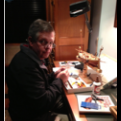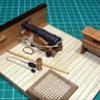Supplies of the Ship Modeler's Handbook are running out. Get your copy NOW before they are gone! Click on photo to order.
×
-
Posts
7,982 -
Joined
-
Last visited
Reputation Activity
-
 Louie da fly reacted to liteflight in 10th-11th century Byzantine dromon by Louie da fly - FINISHED - 1:50
Louie da fly reacted to liteflight in 10th-11th century Byzantine dromon by Louie da fly - FINISHED - 1:50
Love your hose-pullers, Steven - must be a welcome relief after the rowers. They are a splendidly assorted team
The rigging and block-making is also interesting and challenging - I can see that the shrouds will be rigged very soon.
Seeing the pictures and reading your words it occurred to me that this resembles the current method of setting running backstays .
I have heard somewhere that only the weather shrouds are tensioned on some rigs - the lee shrouds are either loosened or unshipped.
Druxey - did you perhaps mean you juste noticed the mot?
Would a motte juste be a proper Norman Castle? Sorry, my Franglais is rusty
-
 Louie da fly reacted to druxey in 10th-11th century Byzantine dromon by Louie da fly - FINISHED - 1:50
Louie da fly reacted to druxey in 10th-11th century Byzantine dromon by Louie da fly - FINISHED - 1:50
Oh, Andrew!! How could you? Thanks for the laugh. That must be the mots 'd'heure oeuf oiel d'eux. But we digress.
-
 Louie da fly reacted to liteflight in 10th-11th century Byzantine dromon by Louie da fly - FINISHED - 1:50
Louie da fly reacted to liteflight in 10th-11th century Byzantine dromon by Louie da fly - FINISHED - 1:50
Digress?
Perish the thought
What they are pulling is da cord
-
 Louie da fly reacted to MESSIS in 10th-11th century Byzantine dromon by Louie da fly - FINISHED - 1:50
Louie da fly reacted to MESSIS in 10th-11th century Byzantine dromon by Louie da fly - FINISHED - 1:50
Superb!
-
 Louie da fly reacted to Sceatha in Greek Galliot by Sceatha - 1/64 - Amati plans with modifications
Louie da fly reacted to Sceatha in Greek Galliot by Sceatha - 1/64 - Amati plans with modifications
Welcome Steven, honoured to have you here!
This illustration has been haunting me a long time now in combination with the Amati plans. There are enough hints of similarities to several traditional Mediterranean vessels to make it very interesting.
George
-
 Louie da fly reacted to liteflight in Viking longship by Cathead - Dusek - 1:35 - FINISHED
Louie da fly reacted to liteflight in Viking longship by Cathead - Dusek - 1:35 - FINISHED
Eric
I realise that I am not sure of the strake numbers, but here goes anyway
I think that the aft end of the problem strake needs to move (in this position) down to establish the right overlap with the darker, redder strake below it, and the end needs to pivot somewhere near the place I have marked
I think that would fill the gap with the next pair of strakes
I hope this suggestion might help
What adhesive have you used for planking - if it is any of the carpentry glues the strakes can be removed with a hot iron. NOT the household Iron unless you have a deeply understanding Admiral.
-
 Louie da fly reacted to bigpetr in Viking longship by Cathead - Dusek - 1:35 - FINISHED
Louie da fly reacted to bigpetr in Viking longship by Cathead - Dusek - 1:35 - FINISHED
It is all realy wierd. I did not build this particular model, but Dusek makes good kits. Did you try to contact them? They are realy nice and helpful. They will send bad parts for free if it is their fault (speak from my own experience)
-
 Louie da fly got a reaction from Schrader in 10th-11th century Byzantine dromon by Louie da fly - FINISHED - 1:50
Louie da fly got a reaction from Schrader in 10th-11th century Byzantine dromon by Louie da fly - FINISHED - 1:50
Thanks for all the likes and the comments.
PhilB, glad to be of service - but be aware that my ship is lateen rigged, while yours would be square rigged, and the rigging plan is different. And I don't believe you need to have that kind of adjustment at the lower end of your shrouds. I've added some info regarding this to your build log.
Making the blocks was rather difficult - at that scale (remembering that these are copies of real ones from archaeology) I couldn't get a drill bit the right size - the holes had to be drilled with a dressmaking pin with the head cut off. And they don't have real sheaves (pulleys) in slots - I just drilled two holes and carved a fake slot and "sheave" between them. Five sets done so far - another 7 to do; then I'll have enough to set up the shrouds.
In the meantime I've also been working on the guys hoisting the after yard. I got a legth of wire to approximate a straight rope (rope's too flexible) so I could get them all in line. Not a perfect job - some of their feet don't touch the ground! -but when I glue them to the deck and replace the wire with a rope there should be enough flexibility to allow everything to work without the slight deviation from a straight line being noticeable. I don't know if you can see that the hands are based on the photos above of me hauling on the garden hose, but I put a lot of work into that and I'm pretty happy with the result.
-
 Louie da fly got a reaction from Cathead in 10th-11th century Byzantine dromon by Louie da fly - FINISHED - 1:50
Louie da fly got a reaction from Cathead in 10th-11th century Byzantine dromon by Louie da fly - FINISHED - 1:50
Thanks for all the likes and the comments.
PhilB, glad to be of service - but be aware that my ship is lateen rigged, while yours would be square rigged, and the rigging plan is different. And I don't believe you need to have that kind of adjustment at the lower end of your shrouds. I've added some info regarding this to your build log.
Making the blocks was rather difficult - at that scale (remembering that these are copies of real ones from archaeology) I couldn't get a drill bit the right size - the holes had to be drilled with a dressmaking pin with the head cut off. And they don't have real sheaves (pulleys) in slots - I just drilled two holes and carved a fake slot and "sheave" between them. Five sets done so far - another 7 to do; then I'll have enough to set up the shrouds.
In the meantime I've also been working on the guys hoisting the after yard. I got a legth of wire to approximate a straight rope (rope's too flexible) so I could get them all in line. Not a perfect job - some of their feet don't touch the ground! -but when I glue them to the deck and replace the wire with a rope there should be enough flexibility to allow everything to work without the slight deviation from a straight line being noticeable. I don't know if you can see that the hands are based on the photos above of me hauling on the garden hose, but I put a lot of work into that and I'm pretty happy with the result.
-
 Louie da fly got a reaction from usedtosail in 10th-11th century Byzantine dromon by Louie da fly - FINISHED - 1:50
Louie da fly got a reaction from usedtosail in 10th-11th century Byzantine dromon by Louie da fly - FINISHED - 1:50
I've been working on the shrouds and the tackle for them. Woodrat was kind enough to send me drawings of the upper fastening of shrouds on various mediaeval Mediterranean lateeners, and I've based mine on these and other contemporary representations.
I used a clothes peg to hold the calcet upright so I could glue the shrouds at right angles to the sheave (i.e. on the sides of the mast)
It was a bit more difficult on the foremast because I'd already glued it in place, so I had to deal with it standing up instead of lying on the bench. And then I wrapped wooldings around mast and shrouds as in the contemporary representations above.
The next thing was to work on the tackle for the lower ends of the shrouds. Deadeyes were an Atlantic invention, and they didn't come into use in the Mediterranean until the 16th century. Instead, shrouds were held to the hull, and tension adjusted, by pairs of blocks - the lower block single-sheaved and the upper block double-sheaved. Single-sheaved blocks have been found on Byzantine wrecks, but I haven't come across any equivalent finds of double-sheaved blocks. However, triple sheaved blocks have been found, so I extrapolated/interpolated between the singles and triples to create what I believe a Byzantine double-sheaved block would have been like.
Threading these things is very fiddly, and they often act like fencing wire - they have a mind of their own and fly off in all directions right in the middle of the process, and get twisted so you thread through in the wrong direction and have to do it all again. So I adapted a method I've seen in setting up deadeyes, which get the tackles the same length and reduces the problem with twisting.
Rather than strops, the main rope is secured by passing through a hole in the block. I've then glued the rope in an eyelet to approximate the look of an eye-splice, which I believe is most likely how they were attached. The rope for the double-sheaved block is short and ends in a toggle. This will pass through an eye-splice in the main shroud, acting as a quick-release mechanism (this technique is still used on Mediterranean lateeners, though I haven't seen it used on shrouds). The free end of the rope from the single-sheaved block will pass through a ringbolt attached to the side of the hull and be tied off. This leaves the tackle between the blocks, which is used to adjust tension. The free end will be belayed to a cleat near the ringbolt.
When I started organising all this I realised I'd made a mistake. There are in fact three different single-sheaved cleats that I've made copies of. The ones in the shroud tackle have a small through-hole at the end (see photo immediately above) to which the tackle between the blocks is belayed. Unfortunately, I used these ones for the tacks and vangs on the yards, when I should have used the other ones I'd made (which were identical except for the little hole in the end). So I had to undo all that work and swap the blocks around. Annoying, but it had to be done.
As I removed a pair of blocks I replaced it with the correct pair and then moved to the next pair. That way I didn't get things mixed up (very easy to do). I used a clothes peg to keep the yard upright, so the blocks would be hanging vertically from the ends of the yard.
And when the blocks had all been removed I was able to re-use them on the shrouds, which is where they were supposed to have been all the time.
More to come in due course.
-
 Louie da fly got a reaction from Chuck Seiler in 10th-11th century Byzantine dromon by Louie da fly - FINISHED - 1:50
Louie da fly got a reaction from Chuck Seiler in 10th-11th century Byzantine dromon by Louie da fly - FINISHED - 1:50
I've finished re-making both the castles.
I had to juggle the spacing between the castles and the pump - basically by slotting the inboard columns further into the body of each castle. Note that I've taken off the rear uprights of the side "walls" and moved them inward, and cut a slot into the back of each column where it crosses the floor structure, so the column sits flush with the back of the "wall".
But now there's (just) enough room for someone to get between the pump and the castles on each side. I thought about removing the capitals from those columns so people wouldn't bash themselves against them, but when it's a contest between aesthetics and practicality, aesthetics has to win (ask Frank Lloyd Wright about his beautiful - but leaky - flat roofs!)
I decided to move the castles a little aft to allow more room for the oarsmen to swing, as mentioned by Landrotten Highlander above, and cut into a couple of the benches a little to allow the columns to slot in. It seems to be the best solution.
Unless you look really carefully you can't see that it's been done, and the oarsmen look better without their reach being obstructed by the columns. I'm not quite ready to glue the castles in place - there are other things that need to be done first - but it will be soon.
But in other ways it hasn't been my day. I discovered I'd miscalculated the number of sheaves necessary for the halyard knights - I'm really rubbish at this sort of thing - the halyard block has three sheaves, but the knight needs four so the downhaul can be pulled horizontally back to the bitts. So I had to start again from scratch to make new knights each with 4 sheaves instead of three. That's three versions of each knight I've had to discard as the build has evolved.
And the fore knight was all finished - in fact it had been glued in - when I realised there was something wrong. In drilling the sheave holes (with a hand drill) I'd somehow got them a bit skewiff so the rope which went into hole number three came out the other side at hole number two! And the same with holes four and three. There was nothing I could do about it - I had to pull the knight out (fortunately the glue was still wet ), trash it and start again. So that's yet another knight I've had to discard and re-make!
But now I've finally completed the fore knight - everything's now all square and ok - installed the tackle from it to the halyard block, glued the foremast in place and temporarily strung the block to the mast. The halyard itself and the rest of its tackle will be added later, but the knight and its tackle had to be done before the mast was glued in place.
I think I should have added the shrouds to the mast before I put it in, but in all the excitement I forgot. I think that can be remedied without too much trouble.
Finally, I've decided to go back to "version two" of the sail configuration, with the foresail hoisted and crewmen clinging to the yard unfurling the sail with the after sail, also furled, in the process of being hoisted up. So I get to use those figures I carved after all.
Today I asked my lovely wife to take photos of my hands as I pulled on a garden hose, pretending it was the halyard downhaul, so I could get the hands correct on the carved figures.
That's it for now. Next I have to make a new 4-sheave knight for the after halyard. Wish me luck!
-
 Louie da fly got a reaction from Boxbuilds in 10th-11th century Byzantine dromon by Louie da fly - FINISHED - 1:50
Louie da fly got a reaction from Boxbuilds in 10th-11th century Byzantine dromon by Louie da fly - FINISHED - 1:50
And some more - the front face of the port castle is done. I re-used the arches -once I'd separated them I just had to trim them a bit to fit.
And here's the castle dry fitted in place. Doesn't look too shabby at all . . . you'd never know I'd stuffed up.
Still working on the back of the castle - If it sticks out too much inboard the crew won't be able to get between the castle and the pump assembly.
And here are the blocks for the tacks and the vangs in place on the yards.
I've made four bitts to take various bits of rigging (halyards, sheets).
And here they are in place. (The aftermost one is a bit hard to see because it's mostly hidden behind the aft crutch for the yards.)
-
 Louie da fly got a reaction from mtaylor in Greek Galliot by Sceatha - 1/64 - Amati plans with modifications
Louie da fly got a reaction from mtaylor in Greek Galliot by Sceatha - 1/64 - Amati plans with modifications
I'm a bit of a latecomer to this build. Looking good. I like your corrections to the kit in line with the illustration, and it's such an interesting shape of vessel!
-
 Louie da fly got a reaction from FriedClams in Viking longship by Cathead - Dusek - 1:35 - FINISHED
Louie da fly got a reaction from FriedClams in Viking longship by Cathead - Dusek - 1:35 - FINISHED
My lovely wife suggested cutting the planks at the nearest frame to the offending point and swivelling the cut-off bit around that spot till it fits in place. The two cut edges would be at somewhat different angles and you would then cut one edge to line up with the other. And do the same with the other strakes if needed. Might not work, but worth thinking about, anyway. If it did you wouldn't have to find more timber for the strakes . . .
-
 Louie da fly got a reaction from mtaylor in Viking longship by Cathead - Dusek - 1:35 - FINISHED
Louie da fly got a reaction from mtaylor in Viking longship by Cathead - Dusek - 1:35 - FINISHED
My lovely wife suggested cutting the planks at the nearest frame to the offending point and swivelling the cut-off bit around that spot till it fits in place. The two cut edges would be at somewhat different angles and you would then cut one edge to line up with the other. And do the same with the other strakes if needed. Might not work, but worth thinking about, anyway. If it did you wouldn't have to find more timber for the strakes . . .
-
 Louie da fly got a reaction from FriedClams in Viking longship by Cathead - Dusek - 1:35 - FINISHED
Louie da fly got a reaction from FriedClams in Viking longship by Cathead - Dusek - 1:35 - FINISHED
This really is terrible, and you deserve better for all the work you've done. The only thing I can think of is to cut yourself some new planking from matching timber - if you can get hold of any in the current global situation.
However, firstly it looks like most of plank 24 is ok. So maybe you could cut it back to the nearest frame to where it goes wrong and keep the bit that fits. If 25 and 26 are so far off that the remaining gap (between them and 23) is far wider than a plank should be, then perhaps cut them back as well and replace their ends with something that has a curve which allows 24 to fit properly.
But that all depends on being able to get timber that matches the existing strakes.
That's all I've been able to think of. I hope it's of some help to you.
-
 Louie da fly got a reaction from BANYAN in 10th-11th century Byzantine dromon by Louie da fly - FINISHED - 1:50
Louie da fly got a reaction from BANYAN in 10th-11th century Byzantine dromon by Louie da fly - FINISHED - 1:50
Thanks for all the likes and the comments.
PhilB, glad to be of service - but be aware that my ship is lateen rigged, while yours would be square rigged, and the rigging plan is different. And I don't believe you need to have that kind of adjustment at the lower end of your shrouds. I've added some info regarding this to your build log.
Making the blocks was rather difficult - at that scale (remembering that these are copies of real ones from archaeology) I couldn't get a drill bit the right size - the holes had to be drilled with a dressmaking pin with the head cut off. And they don't have real sheaves (pulleys) in slots - I just drilled two holes and carved a fake slot and "sheave" between them. Five sets done so far - another 7 to do; then I'll have enough to set up the shrouds.
In the meantime I've also been working on the guys hoisting the after yard. I got a legth of wire to approximate a straight rope (rope's too flexible) so I could get them all in line. Not a perfect job - some of their feet don't touch the ground! -but when I glue them to the deck and replace the wire with a rope there should be enough flexibility to allow everything to work without the slight deviation from a straight line being noticeable. I don't know if you can see that the hands are based on the photos above of me hauling on the garden hose, but I put a lot of work into that and I'm pretty happy with the result.
-
 Louie da fly reacted to druxey in 10th-11th century Byzantine dromon by Louie da fly - FINISHED - 1:50
Louie da fly reacted to druxey in 10th-11th century Byzantine dromon by Louie da fly - FINISHED - 1:50
Very convincing, Steven! Well done.
Oh: and just noticed your mot juste; d'accord!
-
 Louie da fly got a reaction from EJ_L in 10th-11th century Byzantine dromon by Louie da fly - FINISHED - 1:50
Louie da fly got a reaction from EJ_L in 10th-11th century Byzantine dromon by Louie da fly - FINISHED - 1:50
I've been working on the shrouds and the tackle for them. Woodrat was kind enough to send me drawings of the upper fastening of shrouds on various mediaeval Mediterranean lateeners, and I've based mine on these and other contemporary representations.
I used a clothes peg to hold the calcet upright so I could glue the shrouds at right angles to the sheave (i.e. on the sides of the mast)
It was a bit more difficult on the foremast because I'd already glued it in place, so I had to deal with it standing up instead of lying on the bench. And then I wrapped wooldings around mast and shrouds as in the contemporary representations above.
The next thing was to work on the tackle for the lower ends of the shrouds. Deadeyes were an Atlantic invention, and they didn't come into use in the Mediterranean until the 16th century. Instead, shrouds were held to the hull, and tension adjusted, by pairs of blocks - the lower block single-sheaved and the upper block double-sheaved. Single-sheaved blocks have been found on Byzantine wrecks, but I haven't come across any equivalent finds of double-sheaved blocks. However, triple sheaved blocks have been found, so I extrapolated/interpolated between the singles and triples to create what I believe a Byzantine double-sheaved block would have been like.
Threading these things is very fiddly, and they often act like fencing wire - they have a mind of their own and fly off in all directions right in the middle of the process, and get twisted so you thread through in the wrong direction and have to do it all again. So I adapted a method I've seen in setting up deadeyes, which get the tackles the same length and reduces the problem with twisting.
Rather than strops, the main rope is secured by passing through a hole in the block. I've then glued the rope in an eyelet to approximate the look of an eye-splice, which I believe is most likely how they were attached. The rope for the double-sheaved block is short and ends in a toggle. This will pass through an eye-splice in the main shroud, acting as a quick-release mechanism (this technique is still used on Mediterranean lateeners, though I haven't seen it used on shrouds). The free end of the rope from the single-sheaved block will pass through a ringbolt attached to the side of the hull and be tied off. This leaves the tackle between the blocks, which is used to adjust tension. The free end will be belayed to a cleat near the ringbolt.
When I started organising all this I realised I'd made a mistake. There are in fact three different single-sheaved cleats that I've made copies of. The ones in the shroud tackle have a small through-hole at the end (see photo immediately above) to which the tackle between the blocks is belayed. Unfortunately, I used these ones for the tacks and vangs on the yards, when I should have used the other ones I'd made (which were identical except for the little hole in the end). So I had to undo all that work and swap the blocks around. Annoying, but it had to be done.
As I removed a pair of blocks I replaced it with the correct pair and then moved to the next pair. That way I didn't get things mixed up (very easy to do). I used a clothes peg to keep the yard upright, so the blocks would be hanging vertically from the ends of the yard.
And when the blocks had all been removed I was able to re-use them on the shrouds, which is where they were supposed to have been all the time.
More to come in due course.
-
 Louie da fly got a reaction from usedtosail in 10th-11th century Byzantine dromon by Louie da fly - FINISHED - 1:50
Louie da fly got a reaction from usedtosail in 10th-11th century Byzantine dromon by Louie da fly - FINISHED - 1:50
Thanks for all the likes and the comments.
PhilB, glad to be of service - but be aware that my ship is lateen rigged, while yours would be square rigged, and the rigging plan is different. And I don't believe you need to have that kind of adjustment at the lower end of your shrouds. I've added some info regarding this to your build log.
Making the blocks was rather difficult - at that scale (remembering that these are copies of real ones from archaeology) I couldn't get a drill bit the right size - the holes had to be drilled with a dressmaking pin with the head cut off. And they don't have real sheaves (pulleys) in slots - I just drilled two holes and carved a fake slot and "sheave" between them. Five sets done so far - another 7 to do; then I'll have enough to set up the shrouds.
In the meantime I've also been working on the guys hoisting the after yard. I got a legth of wire to approximate a straight rope (rope's too flexible) so I could get them all in line. Not a perfect job - some of their feet don't touch the ground! -but when I glue them to the deck and replace the wire with a rope there should be enough flexibility to allow everything to work without the slight deviation from a straight line being noticeable. I don't know if you can see that the hands are based on the photos above of me hauling on the garden hose, but I put a lot of work into that and I'm pretty happy with the result.
-
 Louie da fly reacted to liteflight in Viking longship by Cathead - Dusek - 1:35 - FINISHED
Louie da fly reacted to liteflight in Viking longship by Cathead - Dusek - 1:35 - FINISHED
Eric,
Sorry to read of and see your dilemma!
Altho' I am not Duseking I can see that this could be the position that I might be in (I am Billing - without cooing)
I think that I agree with the principle of MBP521 (Viking it into place) and the practice of the fragrant Mrs. Louie-d-F.
Suggestion - reproduce the offending plank 24 in say, thin card and fit the end that fits, and then cut across the plank where it starts to fail to fit and see if swivelling it will improve matters - it looks as if it should!
The snagette with this approach might be that A) cutting the plank would remove a slender wedge of plank and make it too short at the ends, so requiring the plank the be made from new in a new shape and b) the sheer line would be altered
If the planks are 1mm ply or something similar can you get any more to remake a plank? Failing that some thin veneer (https://www.cardsofwood.com/) in a suitable wood - I think they do birch and ash veneers about 0.030"
Further thinking with my Engineering/topographers head on - the offending strake needs to rotate about 2 or 3 degrees to meet its mates at the stern, if it pivots amidships or thereabouts - so a cut across the plank around a midship frame would only leave a shallow VEE shape to fill in if the stern end is swivelled, or you could cut/sand a slender wedge out of the strake to allow it to be butt jointed.
Sketch follows, before you wake up 😊
-
 Louie da fly got a reaction from mbp521 in Viking longship by Cathead - Dusek - 1:35 - FINISHED
Louie da fly got a reaction from mbp521 in Viking longship by Cathead - Dusek - 1:35 - FINISHED
My lovely wife suggested cutting the planks at the nearest frame to the offending point and swivelling the cut-off bit around that spot till it fits in place. The two cut edges would be at somewhat different angles and you would then cut one edge to line up with the other. And do the same with the other strakes if needed. Might not work, but worth thinking about, anyway. If it did you wouldn't have to find more timber for the strakes . . .
-
 Louie da fly got a reaction from DaKea90 in Golden Yacht 1683 by Strelok - FINISHED - 1/100 - CARD
Louie da fly got a reaction from DaKea90 in Golden Yacht 1683 by Strelok - FINISHED - 1/100 - CARD
Coming together nicely. The blocks and rigging, and particularly the flags, are very good, especially at 1:100 scale. And yes, there's a lot to be said for the feeling of achievement of painting them yourself instead of letting a computer and printer do the work for you.
-
 Louie da fly got a reaction from MESSIS in 10th-11th century Byzantine dromon by Louie da fly - FINISHED - 1:50
Louie da fly got a reaction from MESSIS in 10th-11th century Byzantine dromon by Louie da fly - FINISHED - 1:50
Thanks for all the likes and the comments.
PhilB, glad to be of service - but be aware that my ship is lateen rigged, while yours would be square rigged, and the rigging plan is different. And I don't believe you need to have that kind of adjustment at the lower end of your shrouds. I've added some info regarding this to your build log.
Making the blocks was rather difficult - at that scale (remembering that these are copies of real ones from archaeology) I couldn't get a drill bit the right size - the holes had to be drilled with a dressmaking pin with the head cut off. And they don't have real sheaves (pulleys) in slots - I just drilled two holes and carved a fake slot and "sheave" between them. Five sets done so far - another 7 to do; then I'll have enough to set up the shrouds.
In the meantime I've also been working on the guys hoisting the after yard. I got a legth of wire to approximate a straight rope (rope's too flexible) so I could get them all in line. Not a perfect job - some of their feet don't touch the ground! -but when I glue them to the deck and replace the wire with a rope there should be enough flexibility to allow everything to work without the slight deviation from a straight line being noticeable. I don't know if you can see that the hands are based on the photos above of me hauling on the garden hose, but I put a lot of work into that and I'm pretty happy with the result.
-
 Louie da fly reacted to mtaylor in Viking longship by Cathead - Dusek - 1:35 - FINISHED
Louie da fly reacted to mtaylor in Viking longship by Cathead - Dusek - 1:35 - FINISHED
You're not putting the planks on upside down are you, Eric? How would 24 fit if you flipped it over? Same for the other 2. They look like they're curving away from the strakes already in place.











